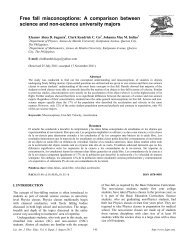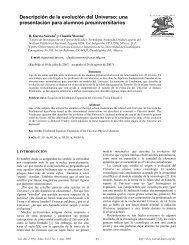Physics by Simulation: Teaching Circular Motion using Applets
Physics by Simulation: Teaching Circular Motion using Applets
Physics by Simulation: Teaching Circular Motion using Applets
You also want an ePaper? Increase the reach of your titles
YUMPU automatically turns print PDFs into web optimized ePapers that Google loves.
Vasudeva Rao Aravind and John W. Heard<br />
v<br />
min<br />
⎛sinθ − μcosθ<br />
⎞<br />
= gr⎜ ⎟ .<br />
⎝cosθ + μsinθ<br />
⎠<br />
(8)<br />
FIGURE 5. Free body force diagram of the car moving on a road<br />
with banking angle θ as the speed of the car approaches the speed<br />
v<br />
max<br />
. The coefficient of static frictional force between the car and<br />
the road is μ . In this case the sum of the components of frictional<br />
force and normal force in the horizontal direction balance the<br />
centripetal term.<br />
In this case the components of frictional force and the<br />
normal force acting down the hill balance the centripetal<br />
term. The condition for limiting equilibrium of horizontal<br />
and vertical forces yield:<br />
2<br />
mvmax<br />
μ FN<br />
cosθ + FN<br />
sin θ = , (3)<br />
r<br />
F cosθ −mg− μF<br />
sinθ<br />
= 0 . (4)<br />
N<br />
From equations (3) and (4) we find that the maximum speed<br />
that the car can have on the slope is given <strong>by</strong>:<br />
C. To find v<br />
min<br />
v<br />
max<br />
⎛sinθ + μcosθ<br />
⎞<br />
= gr⎜ ⎟ .<br />
⎝cosθ − μsinθ<br />
⎠<br />
When the speed of the car approaches v min<br />
, it shows a<br />
tendency to move towards the bottom of the hill. So the<br />
frictional force acts towards top of the hill. The free body<br />
force diagram for the car is shown in figure 6.<br />
In this case the net force along horizontal direction<br />
toward the center provides the centripetal force. The<br />
conditions for limiting equilibrium of the horizontal and<br />
vertical forces yield:<br />
N<br />
(5)<br />
2<br />
mvmin<br />
FN<br />
sinθ − μFN<br />
cos θ = , (6)<br />
r<br />
F cosθ − mg+ μF<br />
sinθ<br />
= 0 . (7)<br />
N<br />
From equations 6 and 7 we find that the minimum speed<br />
with which the car should move along the circular track is<br />
given <strong>by</strong>:<br />
N<br />
FIGURE 6. Free body diagram of the car as the car moves along<br />
the circular track with the minimum speed v min<br />
. In this case the<br />
difference in the normal force and static friction components in the<br />
horizontal direction balance the centripetal term.<br />
V. OUTCOMES OF THE STUDY<br />
In order to evaluate the effectiveness of this pedagogy, the<br />
students were asked to solve a conceptual problem. The<br />
problem given to the students was:<br />
Q. Two curves of a highway have the same radii.<br />
However one is unbanked and the other is banked at an<br />
angleθ . A car can safely travel along the unbanked curve<br />
at a maximum speed v 0<br />
under conditions when the<br />
coefficient of static friction between the tires and the road<br />
is μ = 0.81. The banked curve is frictionless, and the car<br />
can negotiate it at the same maximum speed v 0<br />
. Find the<br />
angle θ of the banked curve.<br />
Solving this problem involves recognizing first of all the<br />
fact that on an unbanked road, frictional force provides the<br />
centripetal force, and the car traveling at maximum speed<br />
means maximum frictional force. Hence,<br />
2<br />
mv 0<br />
= μ mgwhich implies<br />
r<br />
v<br />
0<br />
μ rg .<br />
= (9)<br />
In the case of banked curve without friction, speed with<br />
o<br />
which the car should travel is given <strong>by</strong> substituting θ = 0<br />
in equation (5), which gives us:<br />
v0 = rgtan θ .<br />
(10)<br />
Comparing equations (9) and (10) we have<br />
−1 o<br />
tanθ<br />
= μ = 0.81 orθ<br />
= tan (0.81) = 39 .<br />
Statistical analysis of the solutions given <strong>by</strong> the students<br />
(summarized in figure 8) showed that 73.5% of the students<br />
were able to solve the problem correctly based on the<br />
knowledge of their simulation and the following lecture.<br />
12.2% of the students were able to correctly model the<br />
Lat. Am. J. Phys. Educ. Vol. 4, No. 1, Jan. 2010 38 http://www.journal.lapen.org.mx



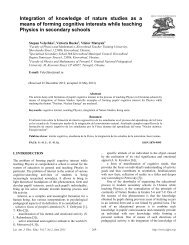
![Diversas formas de visualizar estados en un sistema cuántico [PDF]](https://img.yumpu.com/51151303/1/190x245/diversas-formas-de-visualizar-estados-en-un-sistema-cuantico-pdf.jpg?quality=85)

![Precession and nutation visualized [PDF]](https://img.yumpu.com/50786044/1/190x245/precession-and-nutation-visualized-pdf.jpg?quality=85)
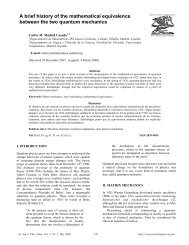
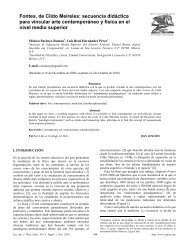
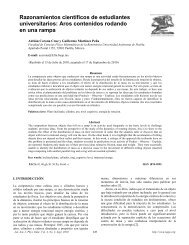

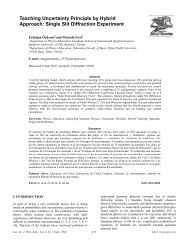
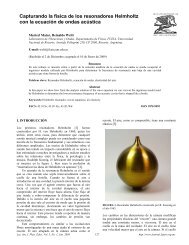
![Index [PDF] - Latin-American Journal of Physics Education](https://img.yumpu.com/47984121/1/190x245/index-pdf-latin-american-journal-of-physics-education.jpg?quality=85)
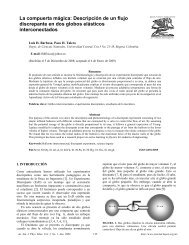
![Flujo de agua en botellas como experimento didáctico [PDF]](https://img.yumpu.com/43536300/1/190x245/flujo-de-agua-en-botellas-como-experimento-didactico-pdf.jpg?quality=85)
